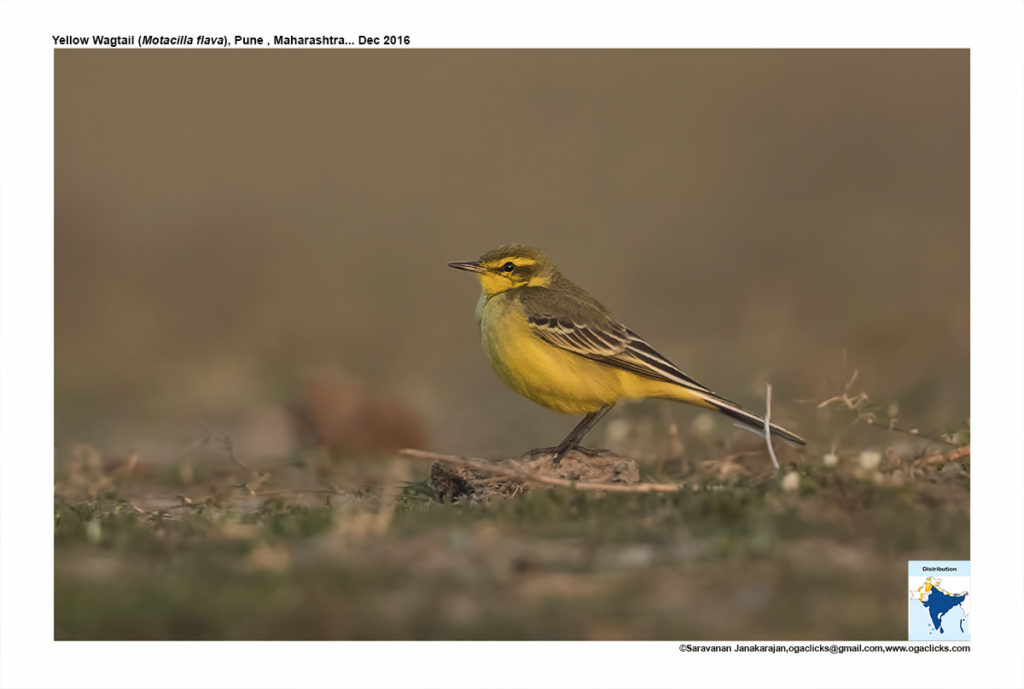Yellow Wagtail

Yellow Wagtail Motacilla flava
Etymology:
- Motacilla : Greek word muttextype of birdmentioned by Hesychius. It is a diminutive of motare, ” to move about”, from medieval times it led to the misunderstanding of cilla as “tail”.
- Flava : Latin word for “golden-yellow, gold-coloured, yellow”
Vernacular Names: Hindi: Pilkya, Pani-ka-pilkya, Sans: Pitta khajjan, Urdu: Pilamamola, Pun: Saleti sir pilamamola, Kala sir pilamamola, Kala sir mamola, Guj: Matanopilakiyo, Bhuramathanopilakiyo, Rakhodimathanopilakiyo, Mar: Pivla dhobi, Pivlaparit, Te: Pachakampajitta, Mal: Charathalayanvalkuluki, Kan: Haladisipilae, Mald: Fanfouduni
Distribution in India:Breeds in Himalayas and wide spread winter visitor in India.
Description: Size of 16·5 cm; male weighs12·3–26·4g, female weighs 11·2–22·6 g. The male nominate race in breeding plumage has blue-grey forehead to nape and hindneck, darker ear-coverts, long narrow white supercilium from bill base to nape side, dark stripe through eye, thin whitish submoustachial stripe. It has upperparts greenish-tinged olive-brown; remiges are blackish, tertials are fringed yellow or buffy white, wing-coverts are blackish, fringed and tipped as greenish-yellow (two wingbars); tail is brownish-black, fringed olive, outer two feather pairs are wholly or largely white; chin, throat and underparts are bright yellow, some green on breast side and flanks, sometimes an indistinct olive or greenish necklace. The underwing-coverts are white; iris is dark brown; bill is greyish to black; legs are slate-grey to black. The male in non-breeding plumage is similar to breeding female, browner above, yellower rump, wingbars less contrasting, dark necklace is more obvious. The female in breeding plumage has duller, less contrasting head pattern, greyish or grey-brown crown, brownish cheeks, upperparts are browner, less yellow; paler and less uniformly yellow below, especially on throat, breast is buffish and variably spotted dark brown, often forming necklace. The non-breeding female is duller than male, paler below, often with more obvious necklace. The immature resembles non-breeding female, may be greener above.
Races of Yellow wagtail :
The races vary mainly in colour and pattern of head of breeding male. The race flavissima male has bright yellow head, more olive on hindcrown, nape, hindneck and ear-coverts, female is darker, browner, above and paler yellow below than nominate.The race lutea male has whole head yellow. The raceiberiae male resembles nominate but has chin and throat white, not yellow, female has darker cheeks and whiter chin. The race cinereocapilla male has white supercilium absent or inconspicuous. The race pygmaea male has dark grey crown and ear-coverts, white chin and throat, lacks supercilium. The race beema male resembles nominate but forehead, crown, hindneck and ear-coverts pale ash-grey and supercilium broader, female has broader and longer supercilium. The race leucocephala male has white head except for yellow center of throat and sometimes greyish hindneck. The race thunbergi male has dark slate-grey forehead, lores, forecrown and ear-coverts shading to dark blue on hindcrown to hindneck, yellow center of chin and throat, some birds with white rear supercilium and some with white stripe below ear-coverts. The racets chutschensis male differs from last in paler grey head, long white supercilium, sometimes blackish ear-coverts. The race simillima malediffers from last in being brighter yellowish-green above, brighter below and generally lacking necklace. The raceangarensis malehas dark slate-grey crown and loral stripe, slate-black ear-coverts, narrow white supercilium. The racemacronyx male differs from previous in paler ear-coverts, no supercilium, brighter green mantle, deeper yellow underparts, more conspicuous wingbars, female is similar but duller or like nominate but darker and without supercilium. The race taivana malehas long, broad deep yellow supercilium, dark ear-coverts and lores, yellow throat, dull greenish crown, nape and upperparts, female is variable, similar to washed-out male, with greenish-brown ear-coverts, paler and slightly narrower supercilium. The race feldegg male has glossy jet-black from forehead to hindneck and down to ear-coverts, sharply demarcated from yellow chin and throat, yellow-tinged wingbars; female has black mottling on head. The race melanogrisea male resembles last but has white stripe separating yellow throat from black cap, upperparts brighter green, sometimes an indistinct olive or greenish necklace, female is similar to last.
Habitat: It is found in variety of damp or wet habitats with low vegetation, from damp meadows, marshes, waterside pastures, sewage farms and bogs to damp steppe and grassy tundra. In non-breeding season uses similar habitats, especially pasture and damp grassland, also cultivations; roosts in reedbeds and similar tall vegetation. It is found from lowlands to 4500 m .
Food habits: It eats small terrestrial and aquatic invertebrates, ranging from weevils and other beetles, dragonflies ,adult and larval flies, termites and ants, spiders ,small snails, crustaceans and worms, fish fry; crumbs and other household scraps also taken. It forages while walking, readily exploiting lawns, bare areas, roads and pavements, roofs and other open areas. It picks at items on the ground or darts forwards (run-picking) to snatch prey; jumps up to take insects in the air or makes short flights to catch aerial prey (flycatching). It sometimes wades in shallow water, picking invertebrates from the surface or in mud, or hovers over water or vegetation to snatch prey. It also forages amidst seaweed along tideline. It follows ploughs on farmland. It is found singly or in pairs.
Breeding habits: They breed in Apr–Aug in India. They are monogamous; solitary and territorial breeders. The nest is built mainly by female. The nest is a grass cup lined with hair, placed on or close to ground in shallow scrape. They lay a clutch of 4–6 eggs. The incubation is done by both sexes, female taking greater share. The incubation period is 11–13 days. The chicksfed by both parents. The nestling period is 10–14 days. The fledglings remain with parents for several weeks. Nests sometimes parasitized by Common Cuckoo.